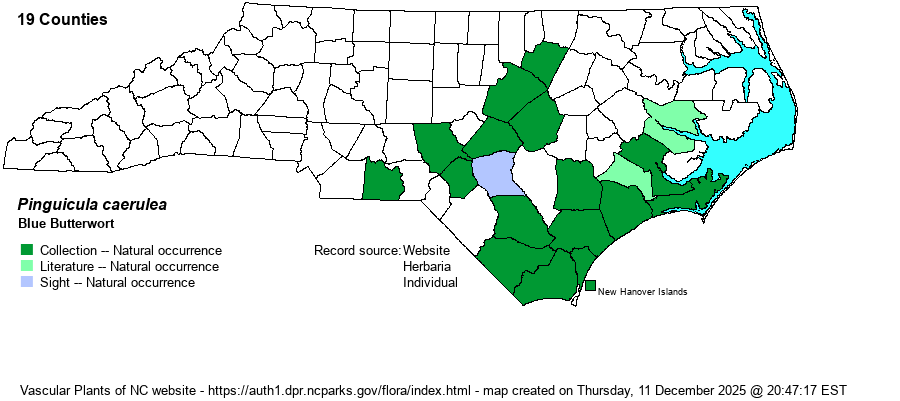| Author | Walter | |
| Distribution | Found across the southern half of the Coastal Plain, including the Sandhills region, though with some odd "holes" in the range not normally seen in "carnivorous" species. Also formerly along the extreme eastern edge of the Piedmont, though it is likely exterminated from that province now. It seems strange that the species would have been recorded from Wake and Franklin counties, for example, and yet lack records in fairly well worked southern Coastal Plain counties such as Sampson, Robeson, Scotland, and Richmond.
This Southern species is essentially limited to the Coastal Plain (except barely along the edge of the Piedmont in NC), from southeastern NC south to southern FL, but west only to the western end of FL. Apparently has not been recorded from AL. | |
| Abundance | It can be fairly common to even locally common in a few well-managed natural areas in coastal counties; however, generally rare over most of its Coastal Plain range, being quite local and mysteriously scarce over much of the western portions from Sampson County west to the southern Sandhills (Scotland and Richmond counties). It does occur sparingly in the northern Sandhills, where scarce and probably limited to well-managed sites. Likely gone now from the eastern edge of the Piedmont. It is not yet scarce enough to be on the NC NHP's Watch List, though this could change in upcoming years. | |
| Habitat | This is a classic Longleaf Pine savanna species, not as wedded to wetter spots such as most pitcherplant (Sarracenia) species and the Venus Flytrap (Dionaea muscipula). It also is found in wet pine flatwoods. Well inland, where savannas are mostly absent, it is found in Sandhill seeps and streamhead ecotones. |
| Phenology | Blooms in April and May, and fruits shortly after flowering. | |
| Identification | The three Pinguicula species in the state have a basal rosette of broadly elliptical, light green leaves that are quite sticky above, to capture insects and spiders. This species and P. lutea have essentially identical leaves, with each leaf averaging about 1-1.5 inches long and with strongly rolled in (curled) margins. However, the flower color of each three separates them; P. caerulea has light to medium blue to light violet-blue flowers. Each flower is on a naked stalk about 6 inches tall, with a quite large flower that has 5 deeply cleft petals (looking a bit like 10 petals); the flower averages about 1.5 inches across. When the species blooms, fortunately it is early enough in spring that most other herbaceous vegetation is short enough that an observer can usually spot a blooming butterwort from many yards away. But, you must wait until flowering to identify it, as Yellow Butterwort (P. lutea) basically has identical leaves. | |
| Taxonomic Comments | None
| |
| Other Common Name(s) | Violet Butterwort, Blueflower Butterwort | |
| State Rank | S3 | |
| Global Rank | G4 | |
| State Status | | |
| US Status | | |
| USACE-agcp | OBL link |
| USACE-emp | OBL link |

